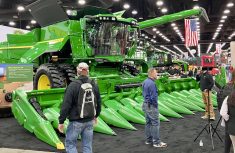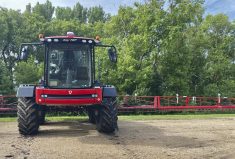This fall at the annual Bauma construction machinery show in Munich, Germany, Volvo Penta, a longtime engine supplier to the industrial and marine industries, unveiled its new eight-litre, dual-fuel hydrogen engine. The company claims the use of renewable hydrogen as a fuel means its new engine will reduce CO2 emissions by up to 80 per cent over diesel fuel.
If hydrogen isn’t readily available, the engine can revert to running on good old-fashioned diesel. And the company says both fuels allow the engine to put out the same horsepower.
Volvo Penta expects to start small-scale production soon and have the dual-fuel engines in the hands of end-users in a pilot project slated for 2023.
Read Also

The pros and cons of new technologies
New farm technology hitting the marketplace can be awfully enticing, and it’s not been unheard of in years gone by…
Volvo Penta is far from the only manufacturer stepping into the alternative fuel arena. The long-talked-about use of hydrogen as an alternative to diesel has seen a significant increase in interest recently. That comes as public concern about reducing greenhouse gas emissions is accelerating. The general consensus among ag and heavy equipment engineers is battery electric drives in high-horsepower applications are not a feasible alternative to diesel engines — at least not if long operating hours are required. That’s helped push hydrogen to the forefront as a green fuel source with lots of potential.
Minimal engine change needed
New Holland has shown a strong interest in pursuing a path to low-carbon agriculture for some time. At Agritechnica several years ago, it was the first to show a concept hydrogen fuel cell tractor which converted hydrogen gas to electricity for an all-electric drivetrain. While many early hydrogen concepts focused on converting it to electricity, like the NH tractor, the dominant trend now is in making hydrogen a replacement fuel for the good old internal combustion engine. That allows for big emissions reductions without fundamentally changing the design.
NH’s partner organization under CNH ownership, FPT (Fiat Powertrain), claims to have already built 50,000 natural gas engines, giving the brand significant engineering experience with ICE engines in the alternative fuel field. But the NH brand has put its spin on the alternative fuels effort, last year releasing a T6 tractor designed to run on methane. NH has been testing bio-methane as a fuel for several years at its low-carbon demonstration farm in Italy.

NH claims that T6 tractor can reduce particulate emissions by 98 per cent and cut operating costs by 30 per cent.
“The T6.180 Methane Power is the result of New Holland’s pioneering work on the use of alternative fuels through our Clean Energy Leader strategy,” said Michael Cornman, livestock and dairy segment manager for New Holland Agriculture North America. “It is a significant step forward on the path to decarbonizing agriculture, and it is happening now, as the development of this sustainable tractor has reached its production phase. It is commercially available to our customers beginning this 2022 season.”
Although the T6 will be available here, it is likely to be a much better fit in Europe for the near term, where on-farm bio-methane is already being produced on several operations. Hydrogen may turn out to be a more popular alternative for North American farmers.
Cummins and AGCO
In late August, Cummins and Winnipeg-based Versatile announced they would be working jointly on development of a hydrogen-powered high-horsepower tractor powered by a 15-litre engine designed specifically for that fuel. A working prototype is expected to be ready for field testing by spring 2023.
“The high commonality among engine components between diesel and hydrogen leverages scale advantages for OEMs, while delivering the reliability that farmers need,” said Ann Schmelzer, general manager for Cummins’ global agriculture business.
“While diesel engines continue to be the flexible power of choice for the foreseeable future in agriculture, such a collaboration enables both companies to develop low- and zero-carbon solutions that are ideally suited to farming,” said Adam Reid, Versatile’s vice-president of sales and marketing.
With new announcements on the alternative fuel front coming pretty regularly now, the timeline of that foreseeable future Reid mentioned may be shrinking.
AGCO’s Power engine manufacturing arm, based in Finland, announced in October it is planning for an inevitable jump into alternative fuels in the ICE market with “a completely new engine family for off-road vehicles.” These new engines, called the CORE platform, can already run on 100 per cent renewable HVO fuels (Hydro-treated vegetable oil, which can be produced from various plant-based oils such as sunflower oil or even animal fats). But that isn’t much of a stretch from current engines. The big deal here is they provide a base engine that can be modified to run with a variety of other renewables, including hydrogen.

“Alternative fuels of the future such as hydrogen, ethanol, methanol, biogas as well as electric hybrid applications set new demands for an engine,” says AGCO Power CEO Juha Tervala. “The CORE engine platform is designed to enable the use of alternative fuels with further development.”
The first CORE engines will hit the market under the hoods of AGCO’s new Gen 7 Fendt 700 Series tractors. It delivers 1,070 foot-pounds of torque at just 1,300 rpm, which the brand claims helps give it the best fuel economy in its class. It can deliver up to 300 horsepower.
“Today, the primary challenge of product development is to get rid of the fossil carbon or at least to radically reduce it,” says AGCO Power’s director of engineering Kari Aaltonen.
Deere and Caterpillar
John Deere has said little about hydrogen so far as an alternative fuel source for its equipment. However, it has committed to delivering a battery/electric autonomous ag tractor to the market by 2026.
Over at Deere’s long-time rival, Caterpillar, that company claims to have a 35-year history in developing hydrogen-fuelled power units. It plans to continue to develop engines capable of running on that energy source. It’s where Cat sees demand growing in the future.
“Caterpillar continues to make investments aimed at improving the capability of hydrogen-powered solutions and replicating them across engine platforms as this fuel will likely play a role in customers’ plans for a reduced-carbon future,” a Cat statement reads.
In October 2021 Cat announced it will begin offering special order generator sets capable of running on 100 per cent hydrogen built to specifically suit certain customers. And it said it would also immediately make units available that can run on a 25 per cent blend of hydrogen along with natural gas.
Earlier in 2021, it announced a partnership with Calgary-based Certarus to work together to “explore opportunities to leverage each party’s strengths to bring lower-carbon energy solutions to their combined customer base.”
Said Joe Creed, Cat’s group president, energy and transportation of the aims of the partnership with Certarus: “We believe our teamwork will combine valuable expertise from our companies to deliver comprehensive customer solutions for the energy transition.”
Did you get the key words in that last sentence? “The energy transition.” It’s already begun.
In the end, though, the future of the hydrogen ICE may depend on the strength of proposed environmental regulations. Indications from European and Californian regulators suggest they may move to entirely ban internal combustion engines no matter what the fuel, to get to near zero greenhouse gas emission levels.
















